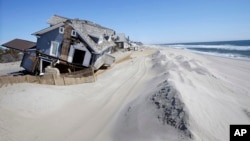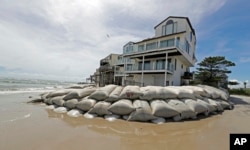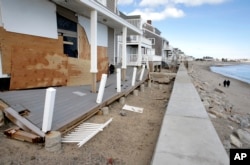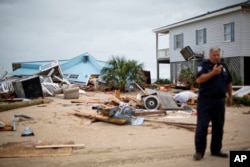When a hurricane comes ashore, few images are more iconic than a million-dollar beach house collapsing into the sea.
Undermined by the ferocity of water, shifting sands and sometimes bad construction, waterfront development takes a beating each time a powerful storm barrels into the Eastern Seaboard.
So why do people keep building on the beach?
"Development of beachfront areas is controversial," writes Florence Duarte of Georgia State University in the report Responsible Beachfront Development. "On one side, a growing human population demands the use of such areas for recreation and work. On the other, environmentalists and biologists hope to preserve these habitats."
A balance
The balance between the human desire to work and play on the water — and developing the waterfront responsibly — often is tested during hurricane and storm season. Despite increased intensity and frequency of storms, rising sea levels and other weather catastrophes, the beach remains the most desirable of destinations: The U.S. Environmental Protection Agency reports that more than half the U.S. population lives along a coast, and 180 million people visit each year.
Housing and rental prices along East Coast beaches in Florida, South Carolina, North Carolina, Virginia, Maryland, New Jersey, New York's Long Island and Cape Cod in Massachusetts exceed the national average because of the views, fresh air and access to water activities. The point of sitting for hours in traffic on a hot, summer Friday is to get away from developed, urban, asphalt centers for the weekend.
Development tapped out
But many resort destinations are reaching maximum development.
In Ocean City, Maryland, a 14-kilometer-long barrier island that is home to about 7,000 permanent residents in the off-season, swells to more than 300,000 vacationers in the summer and on holidays.
"The development has pretty much tapped out," said J.D. Wells, a Realtor and lifelong Ocean City resident. "The oceanfront is completely developed. Any new construction being done is replacing a tear-down that was already there."
Properties that sit along the waterfront or have a view of the ocean can fetch more than double equivalent properties inland, Wells said.
Views and taxes
Towns and cities collect substantial tax revenue from those waterfront and water-view properties, sometimes charging homeowners tens of thousands of dollars more in taxes for the luxury of owning beachfront property. In many areas that have seasonal ebbs and flows, tax revenue from those properties can fill municipal coffers that benefit permanent residents, many of whom cannot afford the waterfront prices of seasonal residents.
"Over the past few decades, society's wealth, attitude and desires have shifted and floodplains are now being developed in more upscale ways," said Andy Coburn, associate director for the Study of Developed Shorelines at Western Carolina University in Cullowhee, North Carolina.
"We can't overlook the demand for coastal land, no matter how vulnerable or risky," he added.
To protect beachfront properties, some towns have pushed back on nature by replacing sand stolen by storms. And while beach replenishment is expensive — Virginia Beach, Virginia, set aside $10 million for six years of sand replenishment — it is not permanent. The ocean is supposed to pound away at the beach, dragging it back out to sea.
In New Jersey, the state earmarked $1.2 billion for projects that reduce hurricane and storm damage, manage coastal storm risk and replenish the beaches that generate nearly half of the state's $45.4 billion in annual tourism dollars.
Building codes for new construction require windows and doors that can withstand high winds and hold back flooding. Wells explained that seawalls and sand dunes are erected as barriers. But nature is mighty.
Powerful even on a normal day, the Atlantic Ocean, when combined with the energy of an extreme storm, can cut through solid land. Residents of Ocean City, Maryland, wandered out after a storm in 1933 to find that a 15-meter wide, 2.5-meter-deep inlet had been sliced into the south end of their barrier island, opening a convenient channel for fishing and pleasure craft between the ocean and the bay.
Likewise, the ocean created an inlet in Chatham, Massachusetts, on Cape Cod, while snatching vintage, brown-shingled cottages into the sea in 2009, according to the Boston Globe newspaper.
"A compromise needs to be found that is responsible to both demands. Rational, sustainable usage of these areas is possible if people are willing to spend time and money in planning," Duarte wrote.
"Bounded by water, coastal and waterfront communities are challenged to make the best use of limited land while protecting critical natural resources from the potentially damaging effects of growth," says the National Oceanic and Atmospheric Administration (NOAA) in its SmartGrowth report. "These communities must consider a common set of overarching issues when managing growth and development."












